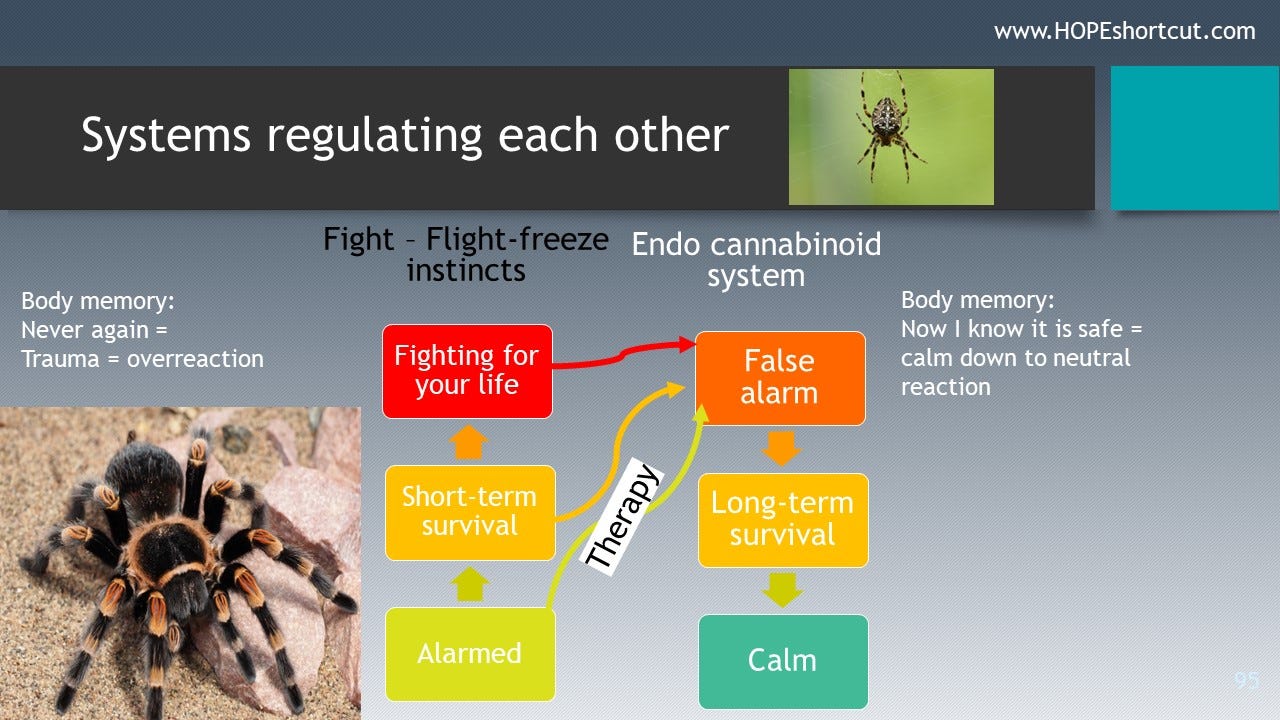If you only see the video: I have an offer for you at the bottom of the page.
We are breaking the myth of chronic diseases, by embracing the mammal nature that also are fully intact in humans.
In previous posts, I have explained how this part of our nature is teasing us in modern life, where we have stopped behaving like the wild creatures we are designed to be
Transcript
Here is the next installment from my long-form conversation with Innovation Scientist, Tony Fitzgerald.
Tony: So Lilian, tell me about how you go about doing that, because I'm really curious to learn? So, you know, I come from this prediction point of view, you talk about these body memories, how do you go about now updating or whatever term you use for this?
Lilian: Because I've seen a video you have shared, I thought I would share my theory, in one slide. I think it's pretty similar, but more basic to all the stuff you have.
We have the fight, flight, freeze instincts that alarm us, and this alarm is actually a dopamine state, "what's going on?" Is it good or bad? Is it a reward or a threat?
And then if our sensory input sort of misinterprets it as something dangerous, we go into the fight, flight, and freeze system, and if it's not treated the right way at that time, it gets stuck as a body memory - forever. Until something new happens, and it could be therapy that we during the therapy tap into this old memory, this old trauma, and find out that in some way dependent on what was going on, that it was a false alarm, maybe it wasn't that big, if it's a phobia like the picture.
Or that your father hit you every day for three years, but you are safe now, you survived, everything is good. And so I do the best I can to create an environment so we go into the old fear, but say: what should have happened in order for this not to be a body memory?
I found that we actually have a system for that, it's called the endocannabinoid system, and there are a lot of things you can do to calm down your system, so you slowly go into the calm state again. So that's my one slide about why therapy works, that we shut down the body memory, the flight, flight, and freeze instinct by using the body's natural way of handling instinct.
Tony: Yes, so Lilian, what you're saying is that then in the brain and the body, it's like this danger is over now.
Lilian: The danger is over, you have been in this danger for 10, 20, 50 years, but now the danger is over, what should have happened at that time in order for this not to become a body memory, it was a false alarm, you were not in danger.
So we recreate a situation close to, as close to via your memory and emotions to what was going on, and then calm it down, and it's often recreating a caring situation with a person that helps you to calm down.
Tony: Yes, Lillian, in your model, you talk about taking them back, so you take them live, almost get that memory live again, is that right? They're back there, and then you talk about helping them, what should have happened then, when you say what should have happened, what do you mean by that?
Lilian: If you take maybe even two twins, they've been in the same situation, they've watched the same thing, maybe they watched a car accident, and that brought up some terrible feelings.
One twin was sort of left to its own and created a body memory, the other was next to a father or mother, and this person gave them a hug and talked about what was going on here, and these people in the accident, they will go to the hospital, and they are taken care of, and so they say, “yes, this was a crisis, but everything is okay, we are all safe, it's nothing to do with you”, or whatever is needed that relates to that situation.
(And only the twin that was left alone got a trauma, due to lack of care)
So I recreate, you can say, a new memory.
Tony: Yes, and you almost change the meaning of the old memory, you change the reaction to that memory, is that right?
Lilian: I mean, I think it's how you are wording it, it's a more philosophical discussion of what's going on, but the brain cannot tell the difference between what happened at that time, and a new happy ending on that memory.
Tony: So based on this, there is a lot of overlap with the understanding the brain is a prediction machine updating itself, and one way to look at what you are doing is to see that change in response is a prediction error, and the brain must update under a prediction error. Yes, update under certain conditions.
Lilian: Yes, if you want to be healthy again. Yes, you must change the prediction if you want to become healthy.
Tony: If you want to be healthy, yes, the condition I was talking about actually, the ones that stop you updating. Yes, there are things to stop the person from changing. We can talk about those another time, but yes, so there's a classic understanding now that, and your technique is based beautifully on it. It uses those three steps beautifully. The understanding is if you look up memory reconsolidation, you probably have from that paper, it's in that paper you shared with me. Talk about memory reconsolidation, and there are three basic steps. Bruce Eckert is probably the leading person to look at, and he's come with therapeutic reconsolidation process.
Those three basic steps from a prediction point of view is one, you activate the target, right? That's what you're doing. Activate that memory because it needs to be live. It needs to be in the body. You're actually experiencing the brain and the body, that whole representation. And now you know you can change it when it's there. You can change the representations. You can change meanings. You can change bits and pieces, endings, and so on.
So that change piece is the prediction error or incompatible information, or it doesn't match what happened in the past. It's updating information. So every therapy that works, works with a transformational type change like you're creating is based on these three steps.
It's that activate some sort of prediction error, some sort of mismatch or incompatible information that you juxtapose against the original. And then the final piece is get them to experience that a number of times. And that's what allows this brain to update that previous memory and update in what you speak about, that body memory (traumas big or small). And then that changes the whole prediction system now. So that stimulus or that memory no longer carries the charge.
Lilian: It's so amazing, and most people actually can do it quite easily as long as you sort of accept that now I'm going to be vulnerable, be in front of a person I don't know too much. Then most people have pretty easy access to this because I think it's the body's natural way of resolving these things.
Tony: The body and the brain's natural way. It's the way that the system is designed to update itself.
Lilian: It's how it's meant to be.
Tony: It's the way the brain is designed, the way that the system is designed to update itself when it gets new information. There's a few conditions on that information providing the update. But yeah, as long as you create an experience and it matches those criteria, then the person will update and they'll have a different, I don't know what you say, a different body memory or no body memory. I'm not sure how you term it. No body memory, is that right?
Lilian: No body memory. Once in a while, if you know the father has hit the child repeatedly, you cannot handle it as one trauma. They are probably different. To give a rude example: A father hits his child once every day, 365 times in a year, it's probably more than one trauma. But it's not 365 traumas because some of the settings are so similar. So maybe the 200 when you were hit in the kitchen in the morning, 9 a.m. these can be pooled and be sort of one trauma session. And then there were times when he hit you in the dining room or out at the beach. Then it can be a different trauma.
So it's a little dependent on the situation. And it can be a trauma that is long term where it takes several hours before something dramatic unfolds. But in general, it's one trauma, one episode of intense emotion. You can clear it out.
And the funny thing is people cannot remember it afterward.
Maybe they have a note in a book, but it's sort of gone because they know they were in this situation. But it's not a big deal.
Tony: Not a big deal, and that's a beautiful moment, right, for you as a therapist, but also for that client to go, wow, this thing has been bothering me all this time. Now it's like, wow.
Lilian: But it's bad for business because, you know, it wasn't a problem. I don't really understand why I went to the therapist because it's never been a problem.
Tony: Isn't that fascinating?
Please inspire me with comments, and emails OR let ME help you to become better.
Offer for substack readers:
For people on substack exclusively, I will make an offer of 1 session for the discounted price of 120 US dollars for a 2-hour session
I usually work with people with chronic illnesses and they need 10 sessions to get a solid start on their path to better health. Of course, it takes a longer time for the therapy to manifest itself in fewer symptoms.
So I need them for a longer period so they can see the results. (Well, not always)... I just received this in an email after a 1st session with a person with Parkinson's:
So click this link and book a session with me
(120 US dollars for a 2-hour session), I will send a payment link back.
Feel free to see all my older substack posts to build trust, or see this page with testimonials.
I do not know how long time this offer will last.
For you who want to see the first substack of mine and get the introduction:
Best regards
Lilian Sjøberg











Unlock the Secret to Natural Healing for chronic Disease! Interview: Prediction as a Cause